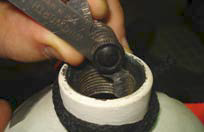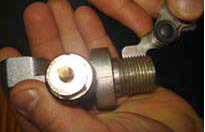Injuries due to failure of diver’s emergency gas cylinder
A member has reported an incident which a valve failed on a diver’s emergency cylinder. The incident occurred on board a diving support vessel (DSV) whilst divers were preparing for a dive and were putting on their diving suits. A valve forcefully parted from a high pressure (HP) compressed air cylinder filled to 180 bar. Five divers were injured by the parted valve as it flew off the cylinder.
Investigation is still ongoing but preliminary assessment has confirmed that the inner thread on the HP cylinder was not compatible with the outer thread of the pillar valve. The pillar valve outer thread was an M25x2 parallel thread and the inner thread of the HP cylinder was a 3/4″x14 TPI parallel thread. How the incompatible valve and HP gas cylinders came to be used together, is still being investigated.


A pillar valve or cylinder valve is the point at which the cylinder connects to the diving regulator. The purpose of the pillar valve is to control gas flow to and from the cylinder. The neck of the cylinder is internally threaded to fit a cylinder valve. Parallel threads are made to several standards and the most common standards are: M25x2 parallel thread, which is sealed by an O-ring, M18x1.5 parallel thread, which is sealed by an O-ring, 3/4″x14 BSP parallel thread, [5] which has a 55° Whitworth thread form, 3/4″x14 NGS (NPSM) parallel thread, sealed by an O-ring, 3/4″x16 UNF, sealed by an O-ring. These parallel threads are very similar but not compatible, as pitch, pitch diameter and thread forms are different.
The main lesson learnt is that the incompatibility of the valve thread and HP cylinder thread led to a serious incident. Members involved in diving operations should perform an immediate check to confirm the compatibility of the HP gas cylinders and valve threads in use at their operations. They should also clearly mark and register both HP gas cylinders and valves separately, so that compatibility can be verified and assured.
The following actions were recommended:
- Make documented check of all HP gas cylinder threads and pillar valve threads for compatibility;
- Mark the cylinder thread size for all HP cylinders; mark the thread size for all pillar valves, applying a unique identification that will be permanently visible and traceable;
- Develop and implement a working procedure and instructions that include the verification of the compatibility of both the pillar valves and HP gas cylinders;
- Include the HP gas cylinder and pillar valve identification numbers in the six-monthly inspection certificates;
- Include compliance with this working procedure in the IMCA DESIGN audits which validate the six-monthly internal and external inspections of HP gas cylinders.
Members may wish to refer to the following similar incidents (key words: thread, incorrect, wrong, pillar, and valve):
Safety Event
Published: 18 December 2014
Download: IMCA SF 19/14
IMCA Safety Flashes
Submit a Report
IMCA Safety Flashes summarise key safety matters and incidents, allowing lessons to be more easily learnt for the benefit of all. The effectiveness of the IMCA Safety Flash system depends on Members sharing information and so avoiding repeat incidents. Please consider adding safetyreports@imca-int.com to your internal distribution list for safety alerts or manually submitting information on incidents you consider may be relevant. All information is anonymised or sanitised, as appropriate.
IMCA’s store terms and conditions (https://www.imca-int.com/legal-notices/terms/) apply to all downloads from IMCA’s website, including this document.
IMCA makes every effort to ensure the accuracy and reliability of the data contained in the documents it publishes, but IMCA shall not be liable for any guidance and/or recommendation and/or statement herein contained. The information contained in this document does not fulfil or replace any individual’s or Member's legal, regulatory or other duties or obligations in respect of their operations. Individuals and Members remain solely responsible for the safe, lawful and proper conduct of their operations.
